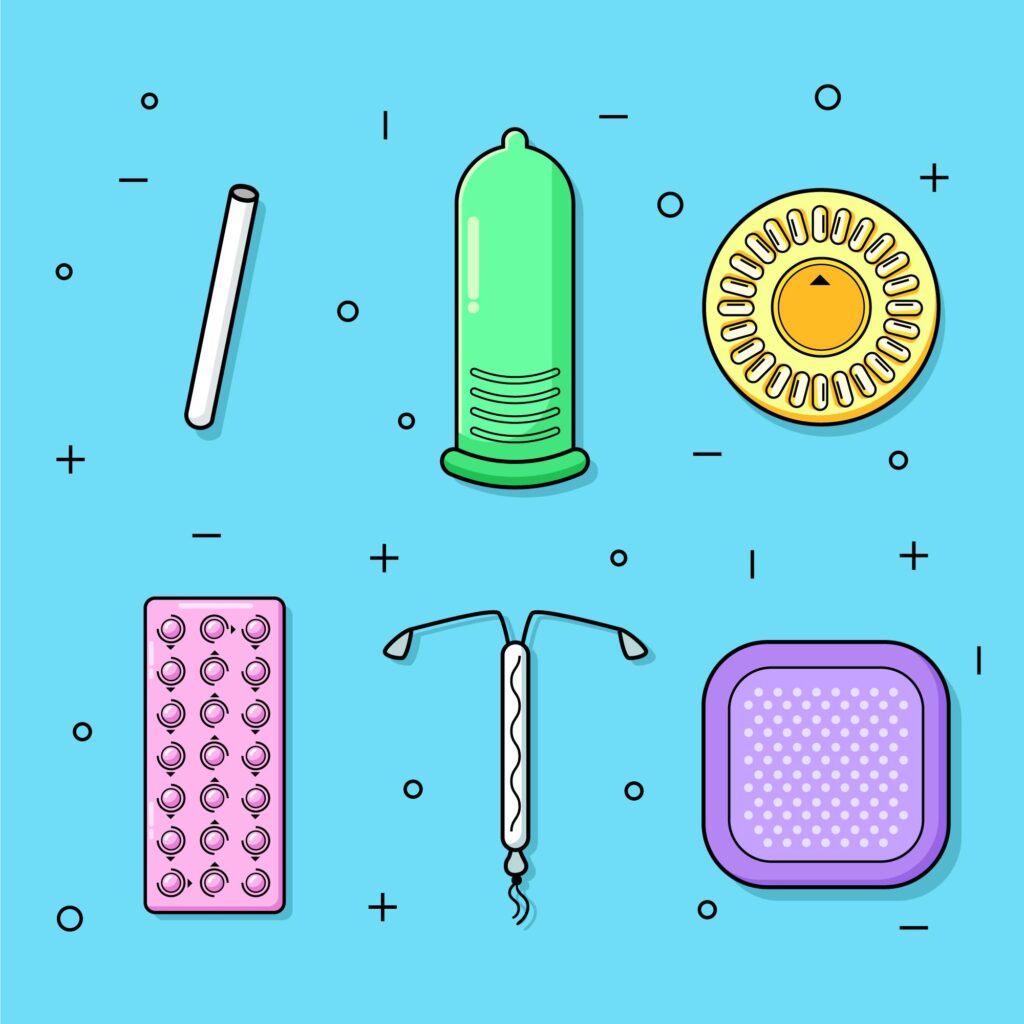Contraception Unraveled: A Guide To Your Choices

If you’re sexually active or planning to be, it’s important to ensure you are using contraception. While condoms are the only way to protect from STIs, there are many choices to protect from pregnancy. Get clued up and make the right choice for yourself.
WARNING: Due to the nature of the subject, some of the content in this blog may not be suitable for some of our younger readers.
This blog is part of our No Shame No Secrets – Sexual Health and Wellbeing Campaign, where we look at many different elements of keeping yourself sexually healthy and safe. You’ll find links to all our campaign blogs here, and follow our social media channels (links at the bottom of the blog) to watch some fun videos.
Why is contraception important?
Using contraception can help avoid pregnancy if you and your partner aren’t ready. You can still have sex, but there’s much less risk of becoming pregnant (no contraception options are 100% effective).
There are many options, and choosing the right one for you can be overwhelming. This blog will give you a better understanding of the different methods, but you should always talk things through with a doctor or sexual health clinic to make sure you’re making the right choice for you.
Using condoms is the only contraception that can also protect you from STIs. If you have unprotected sex with different people, getting a regular STI test is a good idea.
Condoms
98% effective when used correctly
Condoms are thin, stretchy covers most commonly worn over the penis during sex. There are also vaginal condoms that can be inserted into the vagina before sex. They create a barrier between the penis and vagina, preventing sperm from reaching the egg.
Make sure you follow the instructions correctly. If you don’t roll it right, leave enough space at the tip, or use out-of-date condoms, it can increase the risk of breaking or slipping off. Condoms can only be used once. You should never use more than one at a time.
Condoms also help protect against STIs.
Condoms are small and can be carried around discreetly. You can get them in different sizes, textures, materials and flavours, so if someone complains that wearing a condom decreases sensations during sex, they should try different ones to find the right size and sensation for them. There are also latex-free options if you have an allergy.
You can buy them in most supermarkets and pharmacies, or if you’re under 25, you can get them free through the C-Card scheme.
Contraceptive pill
More than 99% effective when used correctly
Birth control pills, commonly called ‘the pill’, are swallowed. They contain hormones, including estrogen and progestin and prevent pregnancy by:
- Stopping an egg being released every month (ovulation). No egg = no pregnancy
- Thinning the lining of the uterus (womb) makes it less likely for a fertilised egg to implant and grow
- Thickening cervical mucus makes it harder for sperm to swim through the cervix to reach the egg.
You’ll be assessed by your doctor to see if the pill is suitable for you. There are different types of birth control pills, including the mini pill and the combined pill. If one doesn’t suit you, you could try another.
You have to take the pill at the same time every day. This can be difficult for people with busy lives or who struggle to remember.
You don’t have to be sexually active to benefit from the pill, as there can be lots of extra benefits too:
- helps with PMS symptoms like pain, bloating and mood swings
- may help control acne or excessive hair growth
- regulate your periods if they are irregular
Side effects can include feeling sick, sore breasts, headaches and mood changes. These improve over time, but if not, contact your doctor.

Emergency Contraceptive Pill
Also known as the morning-after pill (although you have a bit longer to take it). It prevents pregnancy after unprotected sex or contraceptive failure (like a split condom). It only prevents pregnancy – if you’re already pregnant, it won’t get rid of the baby.
To be taken within 3-5 days of having unprotected sex. The sooner, the better – don’t wait. If you’re sick within a few hours of taking the pill, you’ll need to go back and retake it.
Available free (even if you’re under 16) at sexual health (GUM) clinics or minor injuries units or some GPs, young people clinics, pharmacies, or A&E departments. If you’re over 16, you can buy it from most pharmacies.
Side effects can include feeling sick or vomiting, tiredness, sore breasts and changes in your period, but these are usually mild and temporary.
This should only be used in an emergency, not as your go-to for preventing pregnancy. If you’re sexually active and want to avoid pregnancy, use regular contraceptive methods.
The Coil or IUD
More than 99% effective
This is a T-shaped device inserted into your womb through the vagina. It’s a safe, quick and straightforward procedure usually done in a doctor’s office or clinic. It may cause discomfort or cramping, but this is only temporary.
The coil protects against pregnancy for 3-10 years, depending on the type. This means that you don’t have to worry about remembering to take or use contraception.
There are two types:
Hormonal coil
Thickens the cervical mucus and thins the uterus lining, making it difficult for sperm to reach and fertilise the egg or implant in the womb.
Non-hormonal coil
Made of copper, it works by creating an environment that’s toxic to sperm.
Side effects can include changes in your period, including heavier and longer periods, spotting in between or irregular bleeding. Risks of it becoming dislodged in the uterus, so you’ll need regular check-ups.
If you decide you want to get pregnant in the future, you can get the coil removed, and your fertility should go back to normal.
The coil can also be used as emergency contraception within 5 days of having unprotected sex. You can keep it in after and use this as your regular contraception.
Contraceptive Implant
More than 99% effective
The contraceptive implant is a tiny rod inserted under the skin of your arm during a brief medical procedure (this can be uncomfortable and painful, but this is just temporary). It releases a hormone called progestin that helps stop pregnancy for several years.
The implant prevents pregnancy by stopping ovulation, thickening cervical mucus and thinning the uterus lining.
Side effects can include irregular bleeding, spotting, no periods, headaches, feeling sick and sore breasts.
If you decide you want to get pregnant in the future, you can get the implant removed, and your fertility should go back to normal.
Contraceptive Patch
More than 99% effective when used correctly
A small, thin patch that sticks to the skin to release hormones that prevent pregnancy. It is changed weekly and can be hidden in less visible places like the bum, stomach or upper arm.
Side effects can include feeling sick, tiredness, sore breasts, and headaches. It may not be suitable for everyone, like people with sensitive skin, who swim or sweat a lot.
Extra benefits include making periods more regular, lighter, shorter and less painful.
Contraceptive Injection
More than 99% effective
Hormones are injected into the body every 8-13 weeks to provide protection against pregnancy. It stops ovulation, thickens cervical mucus and thins the uterus lining.
Side effects can include changes in your menstrual cycle, irregular, heavier or lighter periods or no period.
If you decide you want to get pregnant in the future, you can stop the injections, but it can take up to a year for your fertility and menstrual cycle to return to normal.
Diaphragm and Cervical Cap
92-96% effective when used correctly
This is a silicone or latex circular dome inserted into the vagina before sex, creating a barrier to the cervix (the opening to the womb) and preventing sperm from entering. You need to apply spermicide (a gel, cream or foam that kills sperm) on the diaphragm or cap and the inside of the vagina before using it.
A healthcare professional has to fit you for a diaphragm or cap, as it must be the right size and you have to be shown how to insert it properly to ensure the cervix is completely covered.
You have to leave it in place for 6-8 hours after sex for it to work. Unlike a condom, the diaphragm and cervical cap are a reusable barrier method of contraception that can last a few years if properly cleaned, dried, and put away each time you use it. But, unlike the condom, a diaphragm or cervical cap can not prevent STIs.
Fertility Awareness Methods
Up to 99% effective if done correctly
Fertility awareness methods (rhythm methods or natural family planning) is a technique where people track their menstrual cycle to understand the days when they are most fertile to avoid unprotected sex.
People using this method understand that there are two main phases – before and after ovulation. They know where they are in their menstrual cycle by tracking this, like taking resting body temperature readings every morning and monitoring the level of mucus from the cervix. You can also use apps to keep track of this information and help predict your most fertile days (when you’re most likely to get pregnant).
For this method to work, it has to be done consistently and accurately. It’s free and doesn’t include hormones, external tools or medication, but it can be less reliable for people with irregular periods or those who don’t have the time or organisation to properly track their menstrual cycle.
Sterilisation
More than 99% effective
Sterilisation is a form of contraception that involves a surgical procedure to prevent pregnancy. You must be sure you don’t want biological children in the future, as this is a permanent solution. There are reversible options, but these can be expensive and not guaranteed.
Female sterilisation involves blocking or sealing the fallopian tubes. These are the tubes that the eggs travel through to reach the uterus during ovulation. This means the sperm cannot reach the egg, which prevents fertilisation and pregnancy.
Male sterilisation, usually called a vasectomy, involves cutting or blocking the vas deferens (the tubes that move the sperm from the testes to the penis). By preventing the sperm from being ejaculated during sexual intercourse, it prevents fertilisation and pregnancy.
Risks include bleeding and infection, the same as it would be for any surgery.
Pulling Out
80% effective if done correctly
Also known as the withdrawal method, is when the penis is removed before ejaculation so that sperm doesn’t enter the vagina. This is the least effective method of contraception and can be very unreliable.
Even before ejaculation, the penis releases small amounts of pre-ejaculate fluid, often called pre-cum, which can contain sperm. Even this small amount of pre-cum can lead to pregnancy if it enters the vagina, so relying on pulling out to prevent pregnancy doesn’t work effectively.
It can be hard to control, needs lots of practice and self-awareness, and even then, it can fail. You also need to put a lot of trust in the other person if you’re not the one ejaculating.
Because of its poor reliability, it’s recommended that you consider one of the more effective and reliable methods of contraception above.
Don’t forget. Using condoms is the only contraception that can also protect you from STIs. If you have unprotected sex with different people, getting a regular STI test is a good idea.
Further information and support
- No Shame No Secrets – Meic’s sexual health campaign
- NHS Your Contraception Guide – methods of contraception which is best for you and addressing any worries or questions
- Brook – sexual health, education and well-being service for young people.
- Sexual Health Clinics – NHS Wales – information about making appointments, how it works, what happens, and getting your results.
- Sexual Health Wales – Frisky Wales – information on STIs, contraception and testing
- C-Card Scheme – Free condoms and sexual health advice for under 25s in Wales

Talk to Meic
Meic is the information, advice and advocacy helpline for children and young people across Wales. Contact Meic if you need to talk to someone about anything that’s worrying or upsetting you. It’s free, confidential and anonymous. The service is open from 8am – midnight every day, and you can contact them by phone, WhatsApp, text, or online chat.





























